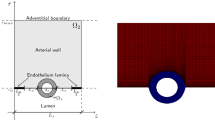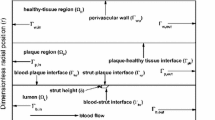Abstract
Objective
There is increasing interest in simultaneous endovascular delivery of more than one drug from a drug-loaded stent into a diseased artery. There may be an opportunity to obtain a therapeutically desirable uptake profile of the two drugs over time by appropriate design of the initial drug distribution in the stent. Due to the non-linear, coupled nature of diffusion and reversible specific/non-specific binding of both drugs as well as competition between the drugs for a fixed binding site density, a comprehensive numerical investigation of this problem is critically needed.
Methods
This paper presents numerical computation of dual drug delivery in a stent-artery system, accounting for diffusion as well as specific and non-specific reversible binding. The governing differential equations are discretized in space, followed by integration over time using a stiff numerical solver. Three different cases of initial dual drug distribution are considered.
Results
For the particular case of sirolimus and paclitaxel, results show that competition for a limited non-specific binding site density and the significant difference in the forward/backward reaction coefficients play a key role in determining the nature of drug uptake. The nature of initial distribution of the two drugs in the stent is also found to influence the binding process, which can potentially be used to engineer a desirable dual drug uptake profile.
Conclusions
These results help improve the fundamental understanding of endovascular dual drug delivery. In addition, the numerical technique and results presented here may be helpful for designing and optimizing other drug delivery problems as well.










Similar content being viewed by others
Abbreviations
- b :
-
bound drug concentration (mol·m−3)
- B :
-
binding site density (mol·m−3)
- c :
-
free drug concentration (mol·m−3)
- D :
-
diffusion coefficient (m2·s−1)
- h :
-
convective mass transfer coefficient (m·s−1)
- Sh :
-
Sherwood number
- t :
-
time (s)
- x :
-
spatial coordinate (m)
- γ :
-
non-dimensional interface location
- μ :
-
forward reaction coefficient for binding (mol·m−3·s)−1
- σ:
-
reverse reaction coefficient for binding (s−1)
- τ:
-
non-dimensional time
- \(\overline{\psi}\) :
-
non-dimensional amount of bound drug remaining
- \(\overline{\chi}\) :
-
non-dimensional amount of drug lost
- \(\overline{\rho}\) :
-
non-dimensional amount of free drug remaining
- \(\xi\) :
-
non-dimensional spatial coordinate
- m :
-
layer number
- ref :
-
reference value
- in :
-
initial value
- A,B :
-
drugs
- ns :
-
non-specific binding
- s :
-
specific binding
References
McGinty S, Pontrelli G. A general model of coupled drug release and tissue absorption for drug delivery devices. J Control Release. 2015;217:327–36. https://doi.org/10.1016/j.jconrel.2015.09.025.
Jain A, McGinty S, Pontrelli G. Theoretical modeling of endovascular drug delivery into a multilayer arterial wall from a drug-coated balloon. Int J Heat Mass Transfer. 2022;187(1-17):122572. https://doi.org/10.1016/j.ijheatmasstransfer.2022.122572
d’Errico M, Sammarco P, Vairo G. Analytical modeling of drug dynamics induced by eluting stents in the coronary multi-layered curved domain. Math Biosci. 2015;267:79–96. https://doi.org/10.1016/j.mbs.2015.06.016.
McKittrick C, McKee S, Kennedy S, et al. Combining mathematical modeling with in vitro experiments to predict in vivo drug-eluting stent performance. J Control Release. 2019;303:151–61. https://doi.org/10.1016/j.jconrel.2019.03.012.
Bozsak F, Gonzalez-Rodriguez D, Sternberger Z, et al. Optimization of drug delivery by drug-eluting stents. PLoS ONE. 2015;10:e0130182. https://doi.org/10.1371/journal.pone.0130182.
McGinty S, Pontrelli G. On the role of specific drug binding in modeling arterial eluting stents. J Math. Chem. 2016;54:967–76. https://doi.org/10.1007/s10910-016-0618-7.
McHugh P, Barakat A, McGinty S. (Eds.). Medical stents: state of the art and future directions. Annals Biomed Eng. 2016;44:274–275. https://doi.org/10.1007/s10439-015-1526-x.
Hwang C-W, Wu D, Edelman ER. Impact of transport and drug properties on the local pharmacology of drug-eluting stents. Int J Cardiovasc Intervent. 2009;5:7–12. https://doi.org/10.1080/14628840304614.
Tzafriri AR, Groothuis A, Price GS, Edelman ER. Stent elution rate determines drug deposition and receptor-mediated effects. J Control Release. 2012;161:918–26. https://doi.org/10.1016/j.jconrel.2012.05.039.
Ma X, Oyamada S, Gao F, et al. Paclitaxel/sirolimus combination coated drug-eluting stent: In vitro and in vivo drug release studies. J Pharm Biomed Anal. 2011;54:807–11. https://doi.org/10.1016/j.jpba.2010.10.027.
Lei L, Guo S-R, Chen W-L, Rong H-J, Lu F. Stents as a platform for drug delivery. Expert Opinion Drug Deliv. 2011;8:813–31. https://doi.org/10.1517/17425247.2011.572068.
Byrne RA, Mehilli J, Iijima R, et al. A polymer-free dual drug-eluting stent in patients with coronary artery disease: a randomized trial vs. polymer-based drug-eluting stents. Eur Heart J. 2009;30:923–31. https://doi.org/10.1093/eurheartj/ehp044.
Roopmani P, Satheesh S, Raj DC, Krishna UM. Development of dual drug eluting cardiovascular stent with ultrathin flexible Poly(l-lactide-co-caprolactone) coating. ACS Biomater Sci Eng. 2019;5:2899–915. https://doi.org/10.1021/acsbiomaterials.9b00303.
Cha J-J, Kim G-C, Hur S-H. Efficacy and safety of dual-drug-eluting stents for de Novo Coronary Lesions in South Korea—The effect trial. J Clinic Med. 2021;10(69):1–9. https://doi.org/10.3390/jcm10010069.
Huang Y, Venkatraman SS, Boey FYC, et al. In vitro and in vivo performance of a dual drug-eluting stent (DDES). Biomater. 2010;31:4382–91. https://doi.org/10.1016/j.biomaterials.2010.01.147.
Escuer J, Schmidt AF, Peña E, Martínez MA, McGinty S. Mathematical modelling of endovascular drug delivery: Balloons versus stents. Int J Pharmceut. 2022;620:121742. https://doi.org/10.1016/j.ijpharm.2022.121742.
Escuer J, Aznar I, McCormick C, Peña E, McGinty S, Martínez MA. Influence of vessel curvature and plaque composition on drug transport in the arterial wall following drug-eluting stent implantation. Biomech Modeling Mechanobiol. 2021;20:767–86. https://doi.org/10.1007/s10237-020-01415-3.
Hickson RI, Barry SI, Mercer GN, Sidhu HS. Finite difference schemes for multilayer diffusion. Mathemat Comput Model. 2011;54:210–20. https://doi.org/10.1016/j.mcm.2011.02.003.
https://www.mathworks.com/help/matlab/ref/ode23s.html, last accessed 06/21/2022.
Ma P, Mumper RJ. Paclitaxel nano-delivery systems: A comprehensive review. J Nanomed Nanotechnol. 2013;4:1000164. https://doi.org/10.4172/2157-7439.1000164.
Kahan BD. Sirolimus: a comprehensive review. Exp Opin Pharmacotherap. 2001;2:1903–17. https://doi.org/10.1517/14656566.2.11.1903.
Oberhoff M, Herdeg C, Baumbach A, Karsch KR. Stent-based antirestenotic coatings (sirolimus/paclitaxel). Catheter Cardiovasc Intervent. 2002;55:404–8. https://doi.org/10.1002/ccd.10034.
Wessely R, Schomig A, Kastrati A. Sirolimus and paclitaxel on polymer-based drug-eluting stents. J Am Coll Cardiol. 2006;47:708–14. https://doi.org/10.1016/j.jacc.2005.09.047.
Levin AD, Vukmirovic N, Hwang C-W, Edelman ER. Specific binding to intracellular proteins determines arterial transport properties for rapamycin and paclitaxel. Proc Natl Acad Sci USA. 2004;101:9463–7. https://doi.org/10.1073/pnas.0400918101.
Díaz JF, Barasoain I, Andreu JM. Fast kinetics of taxol binding to microtubules effects of solution variables and microtubule-associated proteins. J Biol Chem. 2003;278:8407–19. https://doi.org/10.1074/jbc.M211163200.
Wear MA, Walkinshaw MD. Determination of the rate constants for the FK506 binding protein/rapamycin interaction using surface plasmon resonance: an alternative sensor surface for Ni2+–nitrilotriacetic acid immobilization of His-tagged proteins. Anal Biochem. 2007;371:250–2. https://doi.org/10.1016/j.ab.2007.06.034.
Escuer J, Cebollero M, Peña E, McGinty S, Martínez MA. How does stent expansion alter drug transport properties of the arterial wall?. J Mech Behav Biomed Mater. 2020: 103610. https://doi.org/10.1016/j.jmbbm.2019.103610.
Tzafriri AR, Levin AD, Edelman ER. Diffusion-limited binding explains binary dose response for local arterial and tumour drug delivery. Cell Prolif. 2009;42:348–63. https://doi.org/10.1111/j.1365-2184.2009.00602.x.
Funding
Funding from the European Research Council under the European Union Horizon 2020 Framework Programme (No. FP/2014–2020) ERC Grant Agreement No. 739964 (COPMAT) is acknowledged. This work is also partially supported by Italian MIUR (PRIN 2017 project: Mathematics of active materials: from mechanobiology to smart devices, project number 2017KL4EF3).
Author information
Authors and Affiliations
Contributions
S. Salvi –Methodology, Formal Analysis, Validation, Investigation, Data Curation; A. Jain – Conceptualization, Methodology, Formal Analysis, Validation, Investigation, Data Curation, Supervision, Project Administration; G. Pontrelli – Conceptualization, Methodology, Formal Analysis, Validation; S. McGinty – Conceptualization, Methodology, Formal Analysis, Validation. All authors contributed towards Writing Original Draft, Review and Editing.
Corresponding author
Ethics declarations
Conflict of Interest
The authors declare that they do not have any conflict of interest related to this work.
Additional information
Publisher's Note
Springer Nature remains neutral with regard to jurisdictional claims in published maps and institutional affiliations.
Appendix 1: Exact Solution for Irreversible Single Drug Binding in a Two-Layer Geometry
Appendix 1: Exact Solution for Irreversible Single Drug Binding in a Two-Layer Geometry
This Appendix derives an exact solution for two special cases of the general model, for comparison with numerical computations.
Special Case of Diffusion and Irreversible Binding of a Single Drug
First, diffusion and irreversible binding of a single drug in a two-layer geometry is considered. For simplicity, superscript A is dropped from the derivation below. In this case, it is assumed that the binding site density is much larger than the concentration of bound drug, and therefore, the problem defined by equations (11), m=1,2 in non-dimensional form can be linearized as follows:
where \({\overline{\beta }}_{m}={\mu }_{m}^{s}{B}_{m}\) for m = 1,2, following linearization, and diffusion coefficient in the second layer is used for non-dimensionalization.
The associated boundary and interface conditions are given by equations (14)–(15).
Due to the linearization of this problem, an exact solution may be derived using the method of separation of variables. One may write the solution in the following form
Note that sine and cosine terms are not included in Eqs. (38) and (39), respectively, in order to satisfy the boundary conditions at \(\xi =0\) and \(\xi =1\). In addition, in order for Eqs. (38) and (39) to satisfy the governing equations (36) and (37), one must have
Further, in order for Eqs. (38) and (39) to satisfy the interface conditions, one must require
Dividing Eq. (41) by (42), and rearranging, one may derive the following eigenequation to determine the eigenvalues \({\lambda }_{n}\):
Also, without loss of generality, one may assume \({A}_{n}=1\) and obtain, from Eq. (41), \({B}_{n}=\displaystyle\frac{\mathrm{cos}\left({\omega }_{1,n}{\gamma }_{1}\right)}{\mathrm{sin}\left({\omega }_{2,n}\left(1-{\gamma }_{1}\right)\right)}\).
Finally, the remaining constants \({p}_{n}\) may be obtained using the principle of orthogonality for a two-layer body as follows:
This completes the exact solution for the special case of irreversible drug binding in a two-layer body, with which the numerical solution may be compared.
Special Case of Pure Diffusion of a Single Drug
The exact solution for the case of pure diffusion of a single drug in a two-layer geometry can be easily obtained from the derivation above by setting \({\overline{\beta }}_{1}={\overline{\beta }}_{2}=0\) in Eq. (40), resulting in \({\omega }_{1,n}={\lambda }_{n}/\sqrt{{\overline{D} }_{1}};\: {\omega }_{2,n}={\lambda }_{n}\). The rest of the solution is identical to the one presented in the previous section.
Rights and permissions
Springer Nature or its licensor (e.g. a society or other partner) holds exclusive rights to this article under a publishing agreement with the author(s) or other rightsholder(s); author self-archiving of the accepted manuscript version of this article is solely governed by the terms of such publishing agreement and applicable law.
About this article
Cite this article
Salvi, S., Jain, A., Pontrelli, G. et al. Modeling Dual Drug Delivery from Eluting Stents: The Influence of Non-Linear Binding Competition and Non-Uniform Drug Loading. Pharm Res 40, 215–230 (2023). https://doi.org/10.1007/s11095-022-03419-3
Received:
Accepted:
Published:
Issue Date:
DOI: https://doi.org/10.1007/s11095-022-03419-3




